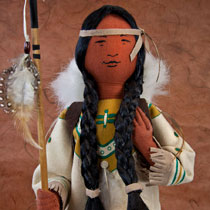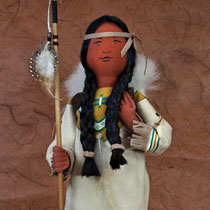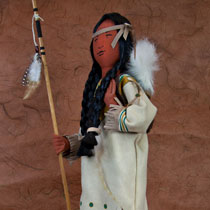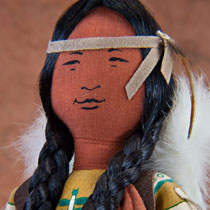Description of Figure/Doll
Female from First Nations, made with stuffed cloth and standing on a wooden base. She is wearing a soft deerskin leather dress that is decorated with feathers, fringe, and intricate paint patters. She is carrying a baby in a fur papoose on her back. She is holding a large wood staff in her left hand that has feathers at the end. Her facial feather are painted on her cloth face. Her synthetic hair is braided, and she has a leather headband. She is wearing leather boots. Tag: “Authenticity Certificate. Limited Edition Collectible #39 of 1500 worldwide Handcrafted by Fait a la main par. The Garment: The Native Indian garment was traditionally an original and personal piece of clothing. Made from elements found in wildlife and nature (deerskin, feathers, bark, fiber…), it also had a spiritual component. Indeed, its ornaments announced the wearer’s tribal affiliation, explits and even marital status. The Fringes: In addition to accentuating the arm and leg movements of dancers, fringes served a useful purpose. In winter, for instance, they helped keep the snow off garments. Made in Canada.”
Link to higher resolution images at ClipPix
Canada: Quebec
Location: Eastern Canada
Capital: Quebec City
Main language: English, French
Currency: Canadian dollar
Figure/Doll
Construction: leather, cotton, wood
Height in Centimeters: 40
Height in Inches: 16

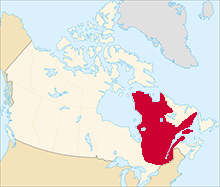
Hunters and Trappers in Quebec: A Marriage of French and First Nations
Reading Level: 4.47
My name is Eduardo and I grew up in the province of Quebec. Quebec is a city, and also a Canadian province. My father moved to Quebec about 300 years ago. He, and many other settlers, came from France.
My dad was a fur trader. He spent lots of time trapping fox, beaver, mink, and raccoons. We lived peacefully alongside many Indian tribes. As a matter of fact, many fur traders married women in the First Nations. My dad was no exception. One day, when he was quite young, he accidentally stepped on a trap. He felt a sharp pain around his ankle. As he looked down, he almost fainted when he saw the clamp biting into his bone. He tried desperately to release his leg but with no success. He laid on the ground screaming for help. Suddenly, he heard someone or something approaching. He drew his knife thinking it might be a bear. When he looked up, he realized it was an Indian girl. She was the most beautiful woman he had ever seen. She smiled and bent down to release the clamp. Though the pain was unbearable, he was glad to be fear of the trap. As his leg healed, they became very good friends. A few months later, he asked her to marry him. Her father agreed, and her tribe helped them build a cabin. It’s the same cabin where I was born. My mother taught my father a great deal about hunting and farming.
Since my father was a fur trader. I learned how to set traps, and I went with my father to collect the various animals. My father’s favorite animal to trap was the fox. The very best time to capture fox was during the winter when the fur was thick. When skinning them, a very sharp knife had to be used. Cleanliness was of the very important. I was never allowed to eat when doing this job. If a hole occurred in the skin, I had to sew that area before stretching the skin. My mother made hats, jackets, pants, skirts and gloves from the skins. We sold them or traded them for supplies.
My family consisted of 7 children. Growing up, we all spoke both French and English. School during those days was nothing like it is now. Our school only had one room and one teacher. Most of us had to walk miles to get to school. During harvest time, the entire school shut down. All of the kids had to be home to help with the crops. Of course, there were no large grocery stores back them. Our food was either hunted, fished, gathered and grown. For meat, we ate bison, caribou and salmon. Our gardens grew corn, beans, and squash. Even today, many people in Quebec speak French, rather than English.

